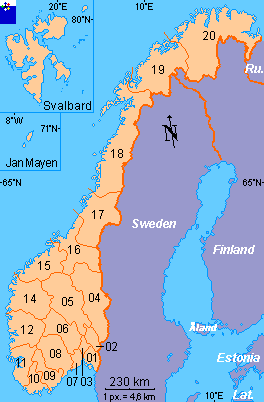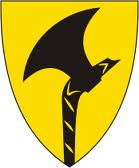History of Norway
and the fylke of Telemark
The Fylkes (Counties) of Norway
Fylkes of Norway
[Wikipedia Links]
|
 Fylkes of Norway
Fylkes of Norway
|
Norway is divided into 19 fylkes (see map above), often referred to as "counties" in english, but geographically more like states in America. Each fylke is divided into smaller administrative units called kommunes. Telemark is comprised of 18 kommunes. These are similar to counties in America.
A fylke may be further subdivided in any of several ways. The church carries out certain administative and governmental duties. Each fylke is divided into parishes, representing one or more churches. Kviteseid has three parishes - Brunkeberg, Kviteseid, and Vradal. In some cases the parish includes more than one church and is then further divided into sokns, one for each church. The parish of Mo, in the fylke of Tokke, is a case where a parish (Mo) is divide into two sokns (Mo and Skafsa).
Another way a kommune can be divided is by gard (farm). A typical kommune might consist of 50 to 100 gards. Because much of Norway is mountainous and not arable, a high percentage of the land area of a gard is not used for farming. Most of the farms were given names by their owners hundreds of years ago. Over time the gards have been divided and sold. The divisions are called bruks, and sometimes have their own names. In most cases the gard name remains unchanged (except for spelling deviations) from its original name.
Sometimes an area within a kommune will be referred to by a name that applies to a geographical region. The area along the Dalaii River in Kviteseid is called Dalane.
Norway
Stories of the Vikings usually begin with the raid at Lindisfarne in 793, on the northeast coast of England, and continue on for several hundred years. The Vikings were traders and raiders, and recent discoveries give them credit for being the first Europeans to reach North America. The Vikings were pagans, and their travels took them as far as Constantinople during the time of the Byzantine Empire.
Harald I Fairhair was the first King of England. His father, Halfdan the Black, ruled over Vestfold (southeast Norway). Harald I became King of all Norway following his victory at Hafrsfjord, near Stavanger, in 872.
Evidence of Vikings reaching North America around the year 1000, was discovered in 1960 at L'Anse Aux Meadows in Newfoundland Canada.
On September 25, 1066, at the Battle of Stamford Bridge, English King Harold Godwinson killed Norwegian King Harald III Hardraade. This battle is traditionally considered to mark the end of the Viking Age. Following that battle, King Harold marched to Hastings where he was killed by William the Conqueror, which brought to an end Anglo-Saxon rule in England.
After 1380, Norway was under Danish rule until May 17, 1814. It then was in a personal union with Sweden until 1905. Norway still celebrates May 17 (Syttende Mai) as its day of liberation from Denmark.
Current Norwegian royalty is King Harald V and his wife Queen Sonja, born Sonja Haraldsen. Sonja's ancestral roots are in Telemark.
|
Important Dates
|
| 793 | - Lindisfarne / start of Viking Age |
| 1000 | - discovery of North America |
| 1066 | - end of Viking Age |
| 1814 | - end of Danish Rule / begin personal union with Sweden |
| 1905 | - Liberation |
Oslo

The area now known as Oslo was called Viken during the Viking Age and included what is now the Swedish province of Bohuslan.During the Middle Ages, control over Viken shifted between Danish and Norwegian kings.
Oslo was founded about 1048 by King Harald Hardråde. It was called Christiania from 1624 to 1848, and Kristiania from 1878 to 1924. Effective January 1, 1925, it was renamed Oslo.
Oslo hosted the 1952 Winter Olympics, beating out Cortina, Italy and Lake Placid, United States. Germany and Japan competed for the first time after WWII.
One of the six Nobel Prizes, The Nobel Peace Prize, is administered by Norway and awarded in Oslo. It is the only Nobel Prize not administered in Sweden.
The population of the city proper was about 560,000 in 2020, exceeding a million when including the Greater Oslo region, making it the third largest Scandinavian city, following Copenhagen and Stockholm.
The County of Telemark
 During the period of Danish rule (beginning 1536) the regions of Norway were known as len. In many cases they were similar in form to the counties we know today. The word len is equivalent to the Swedish word län, meaning county. There were nine principal len and seventeen subsidiary len. Telemark was called Bratsberg len. This lasted until 1662.
During the period of Danish rule (beginning 1536) the regions of Norway were known as len. In many cases they were similar in form to the counties we know today. The word len is equivalent to the Swedish word län, meaning county. There were nine principal len and seventeen subsidiary len. Telemark was called Bratsberg len. This lasted until 1662.
By Danish decree in 1662, each len was designated an amt, coming from the Germanic word amt meaning office. It was used in the context of an administrative region.
In 1919, term was changed to fylke meaning county. Bratsberg amt became Telemark fylke.
Telemark Canal

The Telemark canal links several long lakes using a series of eighteen locks. It allows canal boats to traverse 105 km from Skien to Dalen [map] with an increase in altitude of 72 m. The largest lock at Vrangfoss, comprised of five chambers, has a lifting height of 23 m.
Two boats, the Henrik Ibsen and the Victoria, travel in opposite directions on alternating days. The trip takes about 9 hours each way at a cost of NOK 900. There are 12 stops along the way. See timetable.
[Return to Genealogy Home Page Page]


 During the period of Danish rule (beginning 1536) the regions of Norway were known as len. In many cases they were similar in form to the counties we know today. The word len is equivalent to the Swedish word län, meaning county. There were nine principal len and seventeen subsidiary len. Telemark was called Bratsberg len. This lasted until 1662.
During the period of Danish rule (beginning 1536) the regions of Norway were known as len. In many cases they were similar in form to the counties we know today. The word len is equivalent to the Swedish word län, meaning county. There were nine principal len and seventeen subsidiary len. Telemark was called Bratsberg len. This lasted until 1662.
